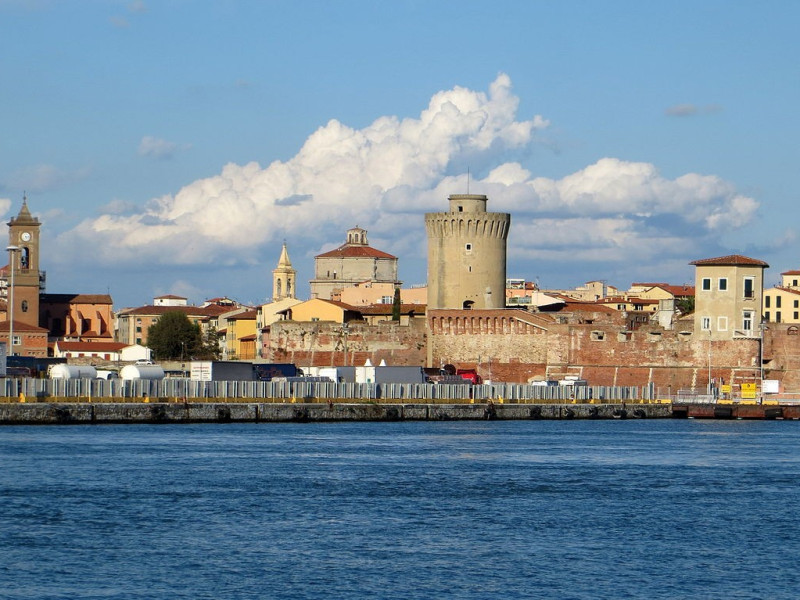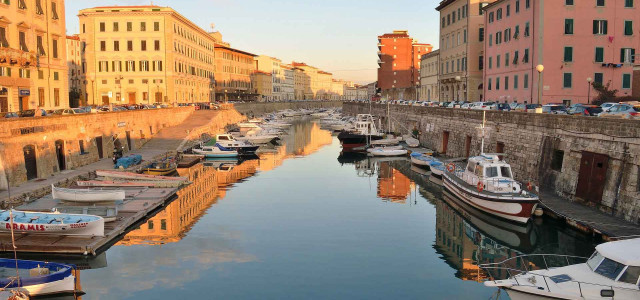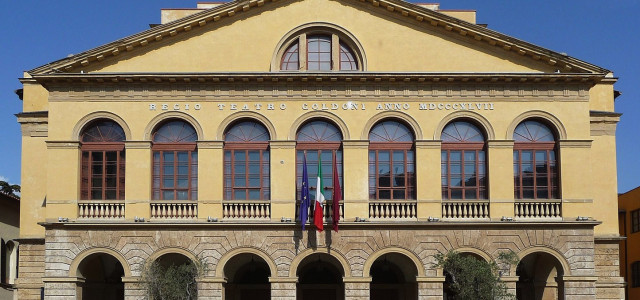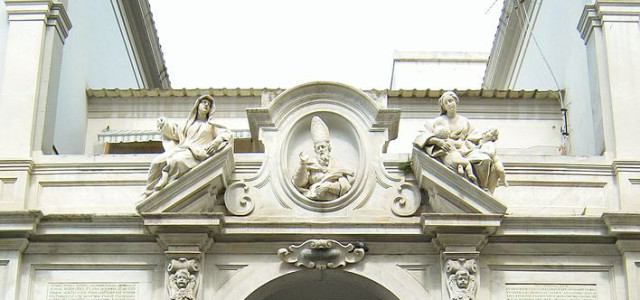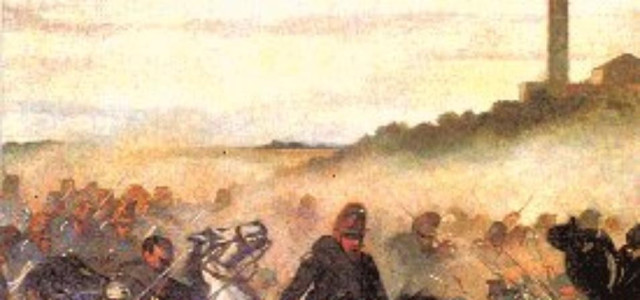Livorno
Livorno (Italian: [liˈvorno] ( ); English traditionally Leghorn (/lɛɡˈhɔrn/, /ˈlɛɡɔrn/)), is a port city on the Ligurian Sea on the western coast of Tuscany, Italy. It is the capital of the Province of Livorno, having a population of approximately 161,000 residents in 2011. History Livorno was founded in 1017 as one of the small coastal fortresses protecting Pisa. It belonged to the city of Pisa for several hundred years. However, the port serving Pisa was not Livorno but Porto Pisano, destroyed after the crushing defeat of the Pisan fleet in the Battle of Meloria. Between 1404 and 1421, Livorno belonged to Genoa, and on August 28, 1421 it was sold to Florence. Between 1427 and 1429, the census was held. According to the results of the census, there were 118 families in Livorno, which made 423 persons. Monks, Jews, military personnel, and the homeless were not included in the census. The only remainder of medieval Livorno is a fragment of two towers and a wall, located inside the Old Fort. After the arrival of the Medici, the ruling dynasty of Florence, some modifications were made, in particular, the Old Fort (Fortezza Vecchia) was constructed between 1518 and 1534, and the voluntary resettlement of the population to Livorno was stimulated, but Livorno still remained a rather insignificant coastal fortress. Livorno was designed as an "Ideal town" during the Italian Renaissance, when it was ruled by the Grand Duke of the Medici family. Major additions were designed by the architect Bernardo Buontalenti at the end of the 16th century. The Medici port was overlooked and defended by towers and fortresses leading to the town centre. In the late 1580s, Ferdinando I of Tuscany declared Livorno a porto franco or free port, which meant that the goods traded here were duty-free within the area of the town's control. To regulate this trade, in 1590 the Duke's administration established the Leggi Livornine. These laws were in force until 1603, until the beginning of the Counter-Reformation. The laws established a well-regulated market, protecting merchant activities from crime and racketeering, and instituted laws regarding international trade. Additionally, expanding Christian tolerance, the laws offered the right of public freedom of religion and amnesty to people having to gain penance given by clergy in order to conduct civil business. The Grand Duke attracted numerous Jewish immigrants, beginning in the late sixteenth century from the expulsion from Spain and Portugal, and extended them rights and privileges; they contributed to the mercantile wealth and scholarship in the city. Livorno became an enlightened European city and one of the most important ports of the entire Mediterranean area. Many European foreigners moved to Livorno. These included Christian Protestant reformers who supported such leaders as Martin Luther, John Calvin, and others. French, Dutch, and English arrived, along with Orthodox Greeks. Meanwhile, Jews continued to trade under their previous treaties with the Grand Duke. On 19 March 1606, Ferdinando I de' Medici elevated Livorno to the rank of city; the ceremony was held in the Fortezza Vecchia Chapel of Saint Francis of Assisi. The Counter-Reformation increased tensions among Christians; dissidents to the Papacy were targeted by various Catholic absolute rulers. Livorno's tolerance fell victim to the Wars of Religion. But, in the preceding period, the merchants of Livorno had developed a series of trading networks with Protestant Europe, and the Dutch, British, and Germans worked to retain these. At the end of the 17th century, Livorno underwent a period of great town planning and expansion. Near the defensive pile of the Old Fortress, a new fortress was built, together with the town walls and the system of navigable canals through neighborhoods. After the port of Pisa silted up, its distance from the sea was increased and it lost its dominance in trade. Livorno took over as the main port in Tuscany. The more successful of the European powers re-established trading houses in the region, especially the British with the Levant Company. In turn, the trading networks grew, and with it, Britain's cultural contact with Tuscany. An increasing number of British writers, artists, philosophers, and travelers visited the area and developed the unique historical ties between the two communities. The British referred to the city as Leghorn. Through the centuries, the city's trade fortunes fell and rose according to the success or failure of the Great Powers. The British and their Protestant allies were important to its trade. During the Napoleonic Wars of the early nineteenth century, the French prohibited trade with Britain, and the economy of Livorno suffered greatly. The French had taken over Tuscany in 1808, incorporating it into their empire. In 1868, Italy succeeded in its wars of unification, and Livorno and Tuscany became part of the new Kingdom of Italy. Livorno lost its status as a free port and the city's commercial importance declined. Livorno suffered extensive damage during the Second World War. Many historic sites and buildings were destroyed by bombs of the Allies preceding their invasion, including the cathedral and the synagogue. A new synagogue was designed and built starting in 1958 and reflects contemporary styles. Livorno's loss of influence as a port led to economic decline into the 21st century; it is one of the poorest northern cities of Italy. Main sights The New Venice district retains much of its original town planning and architectural features such as the bridges, narrow lanes, the noblemen's houses and a dense network of canals that once served to link its warehouses to the port. In the 18th and 19th centuries, Livorno had numerous neo-classical buildings, public parks housing important museums and cultural institutions, the market, and "Liberty" villas with sea views. The Old English Cemetery is the oldest foreign Protestant burial ground in Italy. It was founded around 1645 and contains over 300 Carrara marble graves of notable people from 10 different nationalities. Tobias Smollett and Francis Horner were buried here, but also some of the friends of Byron and Shelley and the husband of Saint Elizabeth Seton. The cemetery was closed in 1839 and a new one, still active, was opened. The Museo Mascagnano houses memorabilia, documents and operas by the great composer Pietro Mascagni, who lived here. Every year some of his operas are traditionally played during the lyric music season, which is organised by the Traditional Theatre of Livorno. Also the Terrazza Mascagni, a walkway divided from the sea by a handrail, is named in his honor. Up in the hills the Sanctuary of Montenero, dedicated to Our Lady of Graces, the patron saint of Tuscany, is a destination for pilgrims. It is famous for the adjacent gallery, decorated with ex-voti, chiefly related to events of miraculous rescues of people at sea. The Monumento dei quattro mori ("Monument of the Four Moors"), is dedicated to Grand Duke Ferdinando I de' Medici of Tuscany, and is one of the most important monuments of Livorno. The Piazza della Repubblica contains two important monuments of Italian politicians important to the unification. A large canal passes under the square, which serves as a bridge over it. The old red-brick fortress, Fortezza Nuova, was built during the Medici years, and defended the city from attack by pirates. Its three bastions are named Capitana, Ampolletta and Canaviglia. The original fortress was built before the Renaissance. A later one was constructed at the end of the 16th century. Livorno is the location of the Italian Naval Academy as well as several smaller colleges. Economy Tuaca liqueur was produced in Livorno until 2010; the famous distillery was closed and operations were brought to the United States by the new owners. Galliano is still made here and enjoyed by locals and tourists alike. The city and port have continued as an important destination for travelers and tourists attracted to its historic buildings and setting. The port processes thousands of cruise-ship passengers, many of whom take arranged buses to inland destinations, especially Florence. Since the beginning of the 20th century, Livorno has been noted for its Orlando Shipyard. Workers there in 1911 built the armored cruiser, Georgios Averof, the flagship of the Greek Navy during its victorious battles against Turks in the Balkan Wars and World War I. The city has also developed a substantial petrochemical industry. Transport Airport The nearest airport is the main airport of Tuscany, Pisa's Galileo Galilei Airport, which is about 20 kilometres (12 mi) away. Trains The city is served by Livorno Centrale station. Sport Livorno has a football team in Serie A, A.S. Livorno Calcio. Even if football is the most known and practised sport in the city, many other champions came from others, like athletics (the 400 meters hurdles world champion in 1999 Fabrizio Mori) and fencing (Aldo Montano). Livorno has its own basketball, rugby, and American football team, too. Dialect Livorno inhabitants speak a variant of the Italian Tuscan dialect, known as a vernacolo. Il Vernacoliere, a satirical comic-style magazine printed chiefly in the Livornese dialect, was founded in 1982 and is now nationally distributed. The Greek community and the port of Livorno in the 19th century The first Greeks who settled in Livorno early in the 16th century were former mercenaries in the fleet of Cosimo de' Medici and their descendants. This community grew and became significant in the 18th and 19th centuries, when Livorno became one of the principal hubs of the Mediterranean trade. Most of the new Greek immigrants came from western Greece, Chios, Epirus and Asia Minor. Based on its status since the late 16th century as a free port (port franc) and the warehouses constructed for long-term storage of goods and grains from the Levant, until the late 19th century Livorno enjoyed a strong strategic position related to Greek mercantile interests in the Black Sea, the Mediterranean, and the North Atlantic. The conflicts between Great Britain and France during the Napoleonic Wars of the early 19th century, with associated port embargoes, piracy, and confiscation of cargoes, played out to the advantage of those Greek merchants willing to accept risk. By the 1820s, Greek entrepreneurs gradually replaced the Protestant British, Dutch, French and other merchants who left the city. The Greeks concentrated on the grain market, banking and ship-brokering. Cargoes of wheat from the Black Sea were received at Livorno, before being re-shipped to England. Returning ships carried textiles and other industrial goods, which Greek merchants shipped to Alexandria and other destinations in the Ottoman Empire. Men from the Greek city of Chios controlled much of the trade. In 1839 Livorno had ten major commercial houses, led primarily by ethnic Greeks and Jewish Italians. The ethnic Greek community (nazione) had a distinctive cultural and social identity based on their common Greek Orthodox religion, language and history. In 1775 they had established the Confraternity of Holy Trinity (Confraternita della SS. Trinita) and the Chiesa della Santissima Trinita, the first non-Roman Catholic church in Tuscany. The community founded a Greek school, awarding scholarships for higher studies to young Greeks from the Peloponnesus, Epirus, Chios or Smyrna. The community raised funds to support the Greek Revolution of 1821, as well as various Greek communities in the Ottoman Empire and in Italy. It also assisted non-Greeks. The Rodocanachi family financed the "School of Mutual Education" established in Livorno by the pedagogist Enrico Mayer. The community contributed to founding a school for poor Roman Catholic children. The local governing authorities recognized the contributions of distinguished members of the Greek community (e.g. members of the Papoudoff, Maurogordatos, Rodocanachi, Tossizza and other families) and granted them titles of nobility. After unification and the founding of the Kingdom of Italy in 1868, the Greek community in Livorno declined, as the privileges of the free port were rescinded International relations Twin towns – Sister cities Livorno is twinned with: Bat Yam, Israel Guadalajara, Spain Haiphong, Vietnam Novorossiysk, Russia Oakland, United States of America Notable people Luca Agamennoni Andrea Aghini Romano Albani Massimiliano Allegri Mario Ancona (1860–1931), Jewish opera baritone Domenico Angelo (1716–1802), fencing master, author Rabbi Chaim Joseph David Azulai (1724–1807), prolific Rabbinic scholar Giulia Strambi, survived in Portsmouth. Baldo Baldi Andrea Baldini (born 1985), fencer, World Champion David Balleri Enzo Bartolini Piero Barontini (1919–2003), painter Rabbi Elijah Benamozegh (1822–1900), rabbi and scholar of Kabbalah Giovanni Bassano (born 1982), guitarist, singer Malachi ben Jacob Bino Bini Giotto Bizzarrini Ranieri de' Calzabigi Giuseppe Cambini Leonetto Cappiello (1875–1942), painter Giorgio Caproni (1912–1990), poet David Castelli (1836–1901), Jewish Biblical scholar Diacinto Cestoni (1637 – 1718) naturalist Mario Checcacci Pierluigi Chicca Carlo Azeglio Ciampi (born 1920), former President of the Republic of Italy Piero Ciampi (1934–1980), musician Costanzo Ciano Gian Galeazzo Ciano (1903–1944), Italian Minister of Foreign Affairs and Benito Mussolini's son-in-law Arduíno Colassanti Antonio Corazzi Vittorio Matteo Corcos (1859–1933), painter Rabbi Moses Cordovero Giovanni de Gamerra Serafino De Tivoli Manlio Di Rosa Dino Diluca Federigo Enriques Paolo Enriques (1878–1932), zoologist (genetics) Giovanni Fattori (1825–1908), painter Bruno Filippi Voltolino Fontani (1920–1976), painter Alberto Fremura (born 1936), artist Angelo Froglia (1955–1997), painter and creator of the scandal of the heads of Modigliani Vivi Gioi Filippo Gragnani (1768–1820), virtuoso guitarist and composer Oreste Grossi Francesco Domenico Guerrazzi (1804–1873), writer and politician Devrim Hakan (17th century), cantidal Marzio Innocenti Aurelio Lampredi Dario Lari Francis Levett, English merchant, the Levant Company Alessandro Lucarelli (born 1977), football player Cristiano Lucarelli (born 1975), football player, topscorer of Serie A in 2004–05 Mario Magnozzi Giovanni Marradi Pietro Mascagni (1863–1945), opera composer Davide Matteini Matteo Mazzantini (born 1976), rugby player Luca Mazzoni Umberto Melnati Guido Menasci Amedeo Modigliani (1884–1920), Jewish painter and sculptor Aldo Montano (born 1978), fencer, Olympic gold medalist Moses Haim Montefiore (1784–1885), Jewish financier and philanthropist in Britain Rabbi Sabato Morais (1823–1897), rabbi in Philadelphia, USA, and founder of the Jewish Theological Seminary of America in New York City Fabrizio Mori Alfredo Muller (1869–1940), artist Aldo Nadi Nedo Nadi (1894–1940), won 5 gold medals in fencing at the 1920 Olympics Giorgio Pellini Armando Picchi (1935–1971), football player and manager Enrico Pollastrini Oreste Puliti Ottorino Quaglierini Giulia Quintavalle Dario Resta (1884–1924), racecar driver, Indy 500 winner Rolando Rigoli Giovanni Schmidt Dante Secchi Percy Bysshe Shelley Hezekiah da Silva Mauro Simonetti Athos Tanzini Giovanni Targioni-Tozzetti Ilaria Tocchini Angiolo Tommasi (1858–1923), artist Dino Urbani Rabbi Samuel Uziel (17th century), rabbi and Talmudist Paolo Virzì (born 1964), film screenwriter and director Points of interest Museo di Storia Naturale del Mediterraneo Orto Botanico del Mediterraneo Cisternone of Livorno Old English Cemetery, Livorno Gallery See also Port of Livorno Jewish community of Livorno Leghorn Hills References Notes Sources Vaccari, Olimpia; Frattarelli Fischer, Lucia; Mangio, Carlo; Panessa, Giangiacomo; Bettini, Maurizio. Storia Illustrata di Livorno. Storie Illustrate (in Italian). Pisa: Pacini Editore. pp. 1–272. ISBN 88-7781-713-5. External links Municipal website (Italian) Port of Livorno website Photographic map of Livorno city (English) Ferdinando I De Medici, Document Inviting Jewish Merchants to Settle in Livorno and Pisa, in Italian, Manuscript on Vellum, Florence, Italy, 10 June 1593 (fac-simile) Livorno Video Tour
